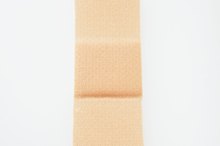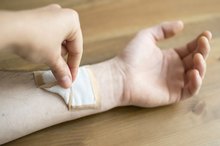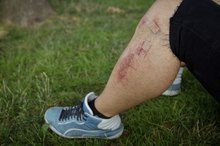How to Heal Blisters Fast From a Baseball Bat
Blisters generally occur when an object moves across the skin in a manner that creates friction 1. On the hands, baseball bats and other handheld sports equipment cause blisters when they rub against delicate skin on the fingers and palm, causing the top layer of skin to separate from a lower layer. Fluid then collects between the layers of skin. Blisters are more likely to occur when the hands are sweaty or moist. Most blisters are easily treated at home. Rarely, blisters may become infected and develop into sepsis or cellulitis, two serious conditions that require immediate medical care.
If you are experiencing serious medical symptoms, seek emergency treatment immediately.
Stop using your blistered hand to hold the baseball bat as soon as you notice a blister forming. Continued friction will worsen blisters and delay healing 1.
How to Lance a Wound
Learn More
Clean the blisters and the area around the blisters with soap and water to remove any dirt and bacteria.
Apply an antibiotic ointment to closed blisters and then cover with a sterile adhesive bandage.
How Can I Make My Scratches Heal Fast?
Learn More
Change the bandage whenever it becomes wet or soiled, and check the blisters several times each day to see if they are still closed.
Sterilize a needle by pouring rubbing alcohol over it, and then carefully lance any large and painful blisters to allow them to drain. It always best to leave blisters intact; drain them only when necessary due to size or for comfort.#
Cover the lanced blisters with antibiotic ointment and a sterile adhesive bandage.
Rub a thin coating of petroleum on the bandage and then place a second bandage on top of the jelly. Do not place the petroleum jelly so that it interferes with bandage adhesion. The jelly coating ensures any friction caused by normal movement takes place between the bandage layers and does not affect the skin, thereby allowing the blisters to heal fast 1.
Tips
If the top layer of skin becomes detached from one or more of your blisters, call your doctor for advice. While this usually does not matter in the case of small blisters, it may increase the risk of scarring and infection.
Warnings
Call your doctor if you are diabetic or suffer from an immune dysfunction that makes you more prone to slow wound healing or infection. You may require special care. Also, call your doctor if you develop significant redness, fever or other signs of infection.
Related Articles
References
- Drugs.com: Friction Blisters
- Shashikumar B, Reddy RR, Harish M. Oral hemorrhagic blister: an enigma. Indian J Dermatol. 2013;58(5):407. doi:10.4103/0019-5154.117337
- Worthing RM, Percy RL, Joslin JD. Prevention of Friction Blisters in Outdoor Pursuits: A Systematic Review. Wilderness Environ Med. 2017;28(2):139-149. doi:10.1016/j.wem.2017.03.007
- Harvard Health Publishing, Harvard Medical School. Frostbite 404 404.
- Institute For Preventive Foot Health. Causes of Blisters.
- PathologyOutlines.com. Skin - nontumor, Blistering disorders, Blood blister.
- U.S. National Library of Medicine, Medline Plus. Blisters.
Writer Bio
Sandra Ketcham has nearly two decades of experience writing and editing for major websites and magazines. Her work appears in numerous web and print publications, including "The Atlanta Journal-Constitution," "The Tampa Bay Times," Visit Florida, "USA Today," AOL's Gadling and "Kraze Magazine."






